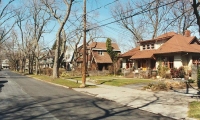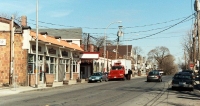The Westcott Neighborhood |
||
HistoryAs Syracuse grew from a small crossroads trading town in the early 1800's to a bustling center fed by the Erie Canal and, later, the state's great railroads, the neighborhood to the east of Syracuse University was still open farmland. The Bastable Farm, Westcott Tract and Stanton Farm were all served by long established roads such as South Beech, which had been an Indian trail long before the settlement of the area and which extended from the canal at the North, through the Eastside farms to the hills of Jamesville to the south. Portions of this tract -- such as the two blocks of Strong Avenue south of Clarke Street -- are still visible in the street pattern. In 1872 Syracuse University's Hall of Languages was the first University building built on fifty acres of farmland. When first developed, the area east of the University served as a conveniently located "streetcar suburb" for the still commercially vibrant downtown. The area attracted large numbers of established middle-class professionals who could afford to build their own homes on newly available lots, or to purchase homes from real estate developers who were actively developing multiple properties. Beginning in about 1910, the erection of two-story family houses in the area increased and many fine examples can be see in the 700 block of Allen Street, along Euclid Avenue and throughout the neighborhood. Only in recent decades has the proximity of the University more fully defined the nature of these neighborhoods. The presence of Syracuse University has caused the conversion of many single family homes into student rooming houses or rentals, but it has also served as a magnet to hold large number of highly educated and civic-minded citizens in the neighborhood. Proximity to the University has provided assurance to homeowners that property values would not, for the most part, decline. The activity of University-affiliated families has also contributed to the strength of the parent organizations that have kept the quality of local public schools high. A popular place to visit from the 1860's through the 1870's was the Stanton Farm carriage-driving course set in the heart of what is now the Westcott East Neighborhood. The driving course was laid out when Heman Stanton leased part of his farm to the Syracuse Driving Park Association, of which Richard W. Jones was president. The result was a half-mile track with grandstand and on-site stables and other out buildings. In 1872 Stanton deeded 21 1/2 acres to the Association. Stephen Bastable bought the driving part after which it was cut into building lots. Contrary to common belief, Concord Place, with its unusual elongated oval form, is not a continuation of the driving course. By 1872, major residential development ventures began in the University neighborhood, with the Highlands on Walnut Park as the centerpiece. Other developments followed to the east: University Heights (in the 1890's) and Berkeley Park (established in 1911). Hillsdale, east of Westcott Street, was laid out in 1892 but was not fully developed until the 1920's. An ad in 1892 for Hillsdale enthused that "[horse-drawn] cars run every 20 minutes to the property and early in the coming summer ELECTRIC cars will run, carrying passengers to Hillsdale in 10 minutes. Streets will be graded, gutters paved and sidewalks laid...no houses will be built on this property costing less than $2,000, which insures you of its being always desirable." Before much of Hillsdale would be realized, James W. Pennock developed the adjacent Pennock Tract -- comprising Allen Street south of Genesee and north of Harvard. Pennock (1842-1929) was born in Yorkshire and came to America with his family in 1854. He was in the shoe business for many years in Boston and Kansas City, where he began to deal in real estate. He moved to Rochester in 1888, and soon thereafter bought eight acres of East Genesee Street in Syracuse and laid out Allen Street, where lots were soon being sold in the late 1890's and houses began to be built soon after. Pennock served for six years as the first president of the Syracuse Park Commission, and also was chairman of the building committee of Central High School. Pennock built two homes in 1912 at the intersection of Allen and East Genesee. For himself he built the large gray-brick house on the corner designed by Albert Brockway. On Allen Street he built what newspapers at the time called an "English cottage" for his daughter Mrs. Charles B. Gould. Pennock's own house -- built in the American Renaissance style, now serves, much altered after a fire, as the offices of Dr. Philip Falcone. It was described as "an American home." The land of what is now Cambridge Street was developed a decade later. A large parcel was owned by Palmer Curtis and passed on to his daughters Harriet and Helen. The father-and-son team of Byron Fellows senior and junior developed Fellows Avenue. Another large land owners in the area at this period of intensive development was A. E. Nettleton. He owned the tract of land between Clarke Street and Euclid Avenue on the east side of Allen. Clarke F. Story, who lived for a time at 440 Allen Street, was the advertising manager for Nettleton. The streetcar line that ran along Westcott Street and Euclid Avenue stimulated housing growth. Noted architects Ward Wellington Ward, Gordon Wright, Albert A. Brockway and others designed many beautiful homes here. By 1917 the area around the University was under heavy residential development. According to a notice in the Post-Standard of March 23, 1912, "One and two family houses and apartment houses are being erected in large numbers on University Hill...the city is growing rapidly in that section with the result that there is a brisk demand for desirable places." The article goes on to list recent lot transfers and new houses built on Ackerman, Buckingham and Sumner. A week later an article details the construction of four housed on Clarendon by the Active developer W. A. Schuyler. An ad on February 24, 1912 states, "University Hill is having the most rapid high-grade real estate development ever known in Syracuse." Since the 1960's, the Westcott neighborhood has been known for the activism of its residents. The term "Westcott Nation" was coined at that time. Neighborhood, Thornden park and school associations draw on energetic, civic-minded residents. The Westcott neighborhood today celebrates its special assets: its people, its schools, its diversity and the mix of shops and businesses on Westcott Street. The beautiful, comfortable and affordable houses in the Westcott neighborhood, and the strong community that these houses are part of, continue to make this a great place to live. |



